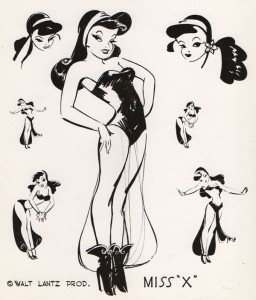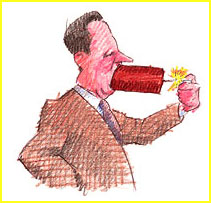Animated Smokey the Bear. Jackson Weaver who was a long time Washington, DC radio personality was the voice of Smokey the Bear from 1950 to 1992 when he passed away.
The character also headlined his own Saturday morning television series produced by Rankin-Bass that ran on ABC during 1969-1970 with Weaver doing the voice. Produced by Rankin Bass as a co-production with Toei Animaton, the series ran for seventeen episodes. Each half-hour show included two cartoons featuring the adult Smokey living in a village of animals like Freddie the skunk and Gabby the mountain lion, with a cartoon of Smokey as a bear cub (voiced by Billie Richards) in between.
Rankin-Bass also did a half hour stop-motion animated TV special The Ballad of Smokey the Bear in 1966 narrated by James Cagney. Steve Stanchfield shared some great animated Smokey the Bear PSAs here.
When we decided to make Planes: Fire & Rescue, our team of filmmakers made several research trips to meet the brave men and women whose job it is to fight wildfires, says Bobs Gannaway, Planes: Fire & Rescue director. Those research trips changed us and forever impressed upon us the importance of wildfire prevention. To have our character, Dusty, take part in the legendary Smokey Bears campaign to prevent wildfires and encourage safe outdoor fire practices is one of the highest honors we could have.

Created pro bono by Disney in 2014, the new English and Spanish television, digital and radio PSAs feature leading characters from the film, including air racer-turned-fire-fighting plane Dusty, spirited air tanker Dipper, veteran fire-and-rescue helicopter Blade Ranger and loving tourists Harvey and Winnie. The PSAs encourage audiences to be Smokey’s Wingman and do their part in preventing wildfires.
 Whats Her Name? Did Miss X ever get a name? As part of a promotion for his 1944 animated short The Greatest Man in Siam (based on a Spike Jone’s song written by his clarinet player Del Porter), Walter Lantz sent out a picture of Pat Matthew’s sexy brunette dancing girl with the following information:
Whats Her Name? Did Miss X ever get a name? As part of a promotion for his 1944 animated short The Greatest Man in Siam (based on a Spike Jone’s song written by his clarinet player Del Porter), Walter Lantz sent out a picture of Pat Matthew’s sexy brunette dancing girl with the following information:
She’s “Miss X” – And She Needs a Name. This curvaceous cutie is Miss X who will be seen on the screen in Walt Lantz’s latest Swing Symphony Cartune film, titled Great Man in Siam. Since Miss X has no other name, Producer Lantz is looking for one, and has offered a $100 War Bond for the best name submitted to him by mail at Universal Studios, Universal City, California on or before April 15. Inspiration for the sultry siren, says Producer Lantz was Maria Montez in the Technicolor Ali Baba and the Forty Thieves.
Interestingly, while the deadline is April 15th, the short came out in March. Film Daily, on Jan 12th 1944, stated Lantz also has ambitious plans for Miss X, his newly-created character who will first be seen in The Greatest Man in Siam. The character also appeared, again with Pat Matthews dancing animation in Abou Ben Boogie (1944).
Plympton and the Tune. In the Boston Sunday Globe October 4th, 1992, animator Bill Plympton talked about his animated feature film The Tune (1992).

“I did a strip for a while and sold gags to Penthouse and Rolling Stone and National Lampoon and places like that. So I always had the sense of humor and I always jotted down funny ideas that I had, so I have a real backlog of gag ideas. I felt when I started animation that this was a chance to use all those gag ideas. In fact 20 Ways to Quit Smoking was originally going to be a book called 101 Ways to Quit Smoking, which I thought would sell like crazy, which I thought publishers would really get excited abou. But, no, they didn’t. No one bought it. So I took the gag ideas and made a film out of it.
“They were basically my assistants (referring to the six artists listed in the credits for The Tune). What they would do is take my drawings when I was done with them, xerox them and paint in the colors with watercolors, the flat colors, cut them out with Exacto knives and paste them on cels. And then I would go in with my color pencil and do all the detail work the shadows under the nose, the shadows under the ear, the fabric shadows, outlines and things like that. And then wed shoot it and match it to the sound, and that was basically it. Roughly 30,000 drawings.
“That’s fun. Its real stream of consciousness concept and I wanted people to just get lost in it. You get sucked into this thing and you start seeing all the stuff – theres no chance to realize whats going on. It’s almost unconscious. It was totally fun throughout the thing. I ever had a hard time at all. I would get up at eight oclock every morning, put on my Walkman, listen to the music and just draw these characters all day long until midnight. And it was just a total ball.
“I admit it. It’s flat-out entertainment and nothing else. Theres no artistic pretense. It looks normal to me. That’s the way Ive always done my drawing so I figure thats real. Thats reality to me.
The Simpsons Halloween. In the October 10-23, 2016 issue of TV Guide magazine, “There are no rules with our Halloween shows,” said The Simpsons staffer Joel Cohen, “But there are certain times when we’ve gone, Whoa! This is getting a little too gross! Then we pull back on the mangling a bit just to the edge of bad taste.”
 Katzenberg on Aladdin. From the New York Times November 8, 1992: When asked about Steven Spielberg’s success with animated features, Disney’s Jeffrey Katzenberg responded, “It does scare us to think that somebody else is going to come along and do better. Animation has totally seduced me.
Katzenberg on Aladdin. From the New York Times November 8, 1992: When asked about Steven Spielberg’s success with animated features, Disney’s Jeffrey Katzenberg responded, “It does scare us to think that somebody else is going to come along and do better. Animation has totally seduced me.
“Our business is laid out so far into the future, if Aladdin tanks on us, if we have made some terrible miscalculation here, which is possible, its going to be years before we get it fixed. Whatever the movie gods decide is the fate of Aladdin, the die is already cast.
“For the last year and a half having Robin’s performance as strong as it was and not knowing whether we had a beginning, a middle and an end there is no question the potential was there for him to completely overwhelm the movie. But now when hes not on the scrren, theres enough storytelling and enough of a romance that Im not sitting there tapping my foot saying, O.K. this is nice but whens he coming back.”


 Jim Korkis is an internationally respected animation historian who in recent years has devoted his attention to the many worlds of Disney. He was a columnist for a variety of animation magazines. With his former writing partner, John Cawley, he authored several animation related books including The Encyclopedia of Cartoon Superstars, How to Create Animation, Cartoon Confidential and Get Animated’s Animation Art Buyer’s Guide. He taught animation classes at the Disney Institute in Florida as well as instructing classes on acting and animation history for Disney Feature Animation: Florida.
Jim Korkis is an internationally respected animation historian who in recent years has devoted his attention to the many worlds of Disney. He was a columnist for a variety of animation magazines. With his former writing partner, John Cawley, he authored several animation related books including The Encyclopedia of Cartoon Superstars, How to Create Animation, Cartoon Confidential and Get Animated’s Animation Art Buyer’s Guide. He taught animation classes at the Disney Institute in Florida as well as instructing classes on acting and animation history for Disney Feature Animation: Florida.




















































You would think, given her popularity overseas with the service men and every man in general, that M.G.M would have done the same style contest for Avery’s “Red Hot” character (the only time she gets a proper name is usually whatever character she plays..).
I never realized that Walter Lantz had his own “red” character, and I don’t think that “ABOU BEN BOOGIE” is on either of the WOODY WOODPECKER AND FRIENDS DVD sets so magnificently put together. I would gather that there have been festivals, though, that may have paired the Tex Avery “red” cartoons with either of the two Lantz cartoons discussed above. Beautiful stuff, and those “swing” cartoons have some of the best music in toons beyond Carl W. Stalling!
I “red” (a-HEM) about Walter Lantz’s character once before, in Don M.Yowp’s Tralfax blog.
I recall that James Cagney (Mister Roberts) did the narration and was the voice of Big Bear for The Ballad of Smokey The Bear and was part of The General Electric Fantasy Hour and aired on NBC TV. “TBOSTB” was origanally done in stop motion Animagic by Tadahito”Tad” Mochinaga with cooperation of MOM Productions of Japan with and designed by Don Duga (Cricket in the Hearth).
Rankin-Bass later “re-booted” Smokey into the cel animated The Smokey Bear Show starring Billie Mae Richards, Paul Soles and Jackson Weaver as Smokey the Bear. This Saturday morning series was animated by Toei Animation (Sally the Witch, the original Cyborg 009, Calimero, Candy Candy, Magic Boy, Gulliver’s Travels Beyond the Moon,Jack and the Witch, The Great Adventures of Horus Prince of the Sun aka The Little Norse Prince Puss in Boots, etc), and broadcast on ABC in 1969-71.
“The Tune” is still a favorite of mine, even if a good half of it is reused footage from previously-made shorts, and the plot is bare bones.
Both Abou Ben Boogie & The Greatest Man in Siam are on Woody Woodpecker & Friends Vol 1 disk 2.
This was a very sexy and very limited character as was the gal from RED HOT RIDING HOOD. Both exist solely to drive the male characters mad with lust. Nothing wrong with that of course. Note the sustained erections in the background art as well as the vagina and erection gags in GREATEST MAN IN SIAM. The censors were not watching when Shamus slipped that one by. The film is a veritable orgy of the forbidden in animation at the time.
I’d always just assumed the name ‘Miss X’ itself was an attempt to slip past the censors a name which sounds like ‘Miss Sex.’
According to Rick Goldschmidt’s THE ENCHANTED WORLD OF RANKIN/BASS, Cagney would only agree to narrating Smokey the Bear if Arthur Rankin could get President Johnson to ask him–which he did with an official letter on behalf of the Forestry Service.
And let’s not forget Smokey’s memorable cameo in Disney’s 1956 short IN THE BAG, though Smokey was animated in a limited “Marvel Super Heroes”-style and was “voiced” by Jackson Weaver via archival audio from one of his ads.
Smokey later cameo’d as an animated poster in the television special THE RANGER OF BROWNSTONE. This time around, Weaver recorded fresh dialogue.
For Greg Ehbahr’s own column, , MGM’s 1966 “Smokey Keep America Bueaitufl” record album, which I had in those days..:)
Al Kilgore told me an anecdote about how around the time of the Smokey the Bear campaign, Jay Ward wanted Dudley DoRight to go after a pyromaniac named Stokey the Bear, who starts fires. They were almost finished when Federal Agents came in and confiscated the film! They said we wouldn’t be allowed to undermine the Parks Services campaign! Al said ” This was before Watergate, when you questioned the governments motives. We just glumly went along onto something else.”
Clearly an old guy stretching the truth to make a better story.
The Stokey episode was finished, and supposedly aired once after which the Forest Service requested it be pulled from future network airings. No raid by the Feds.
It was later released on DVD and can be seen on YouTube.
Ironically, Katzenberg would establish Dreamworks with Spielberg and Geffen in 1994 after he left Disney.
I’d always assumed that the transition from Smokey THE Bear to merely Smokey Bear occurred with the 1969-70 Rankin-Bass ABC cartoon series. However, if you look at the promotional comic book THE TRUE STORY OF SMOKEY THE BEAR (drawn by Mo Gollub) sponsored by the U.S. Forest Service (a cut-down sixteen-page reprint from SMOKEY THE BEAR: HIS LIFE STORY #932, 1958, Dell), of which there have been at least five printings (1959, 1960, 1964, 1969 and 1991), the 1964 version has a paste-over logo altering the title to THE TRUE STORY OF SMOKEY BEAR. So someone in the U.S. Department of Agriculture decided that their famous mascot needed to have a shorter name somewhere between 1960 and 1964. Why is anyone’s guess. Significantly, the Forest Service (at least as of a decade ago) was in full denial mode about Smokey ever having been called “THE Bear,” usually in reaction to the joke about Smokey’s middle name. This despite the fact that anyone who is able to read and owns a computer can find hundreds of items with “Smokey the Bear” on them (including seven further Dell issues starring “Smokey THE Bear,” a 1955 Little Golden Book, a 1958 Golden Stamp Book, et al.) can prove that to be incorrect. The 1960 Little Golden Book “Smokey and His Friends” avoids the controversy altogether.